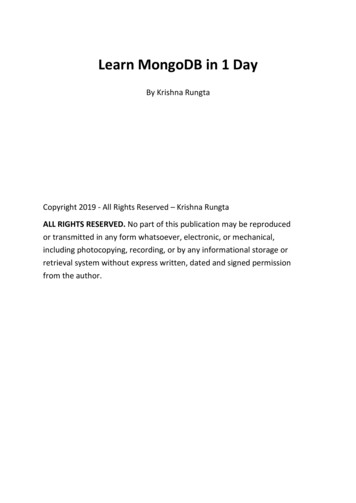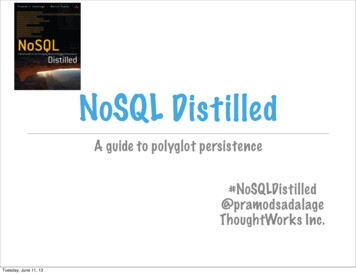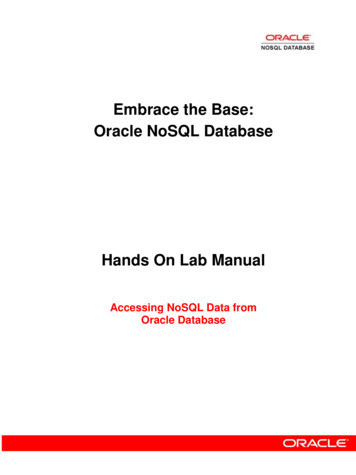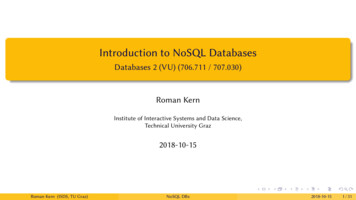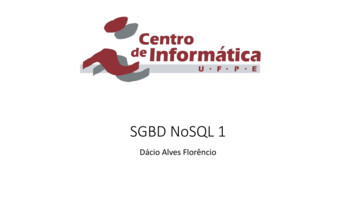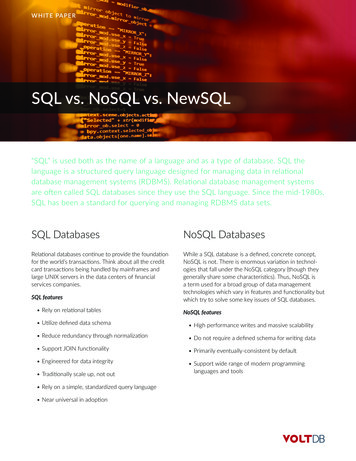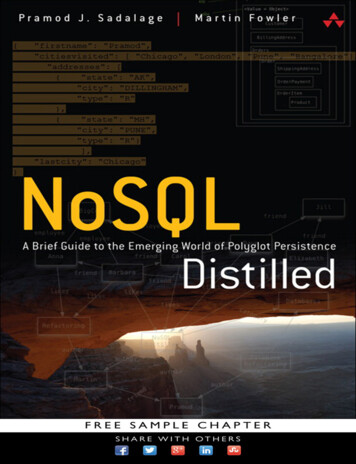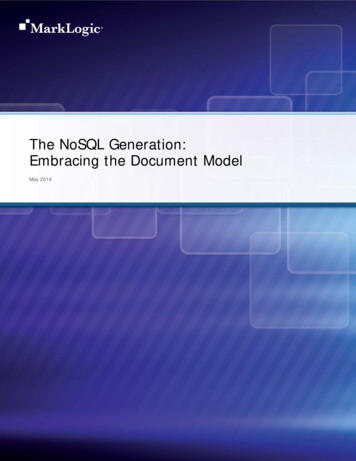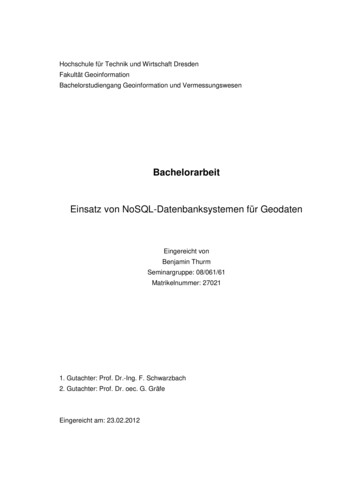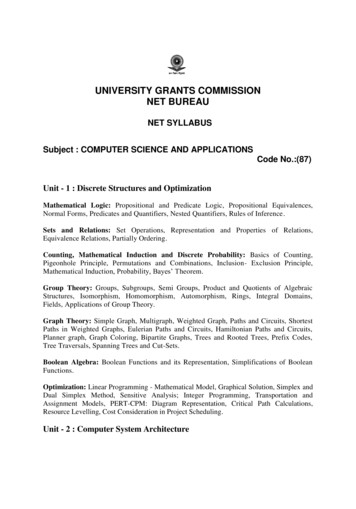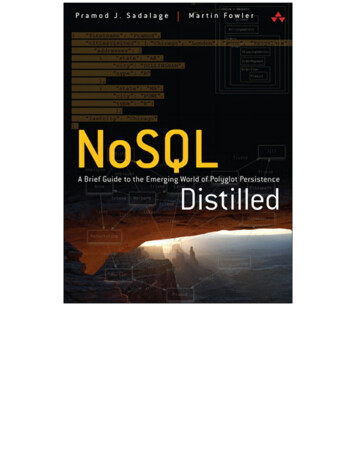
Transcription
NoSQL DistilledA Brief Guide to the Emerging World of Polyglot PersistencePramod J. SadalageMartin FowlerUpper Saddle River, NJ Boston Indianapolis San FranciscoNew York Toronto Montreal London Munich Paris MadridCapetown Sydney Tokyo Singapore Mexico City
Many of the designations used by manufacturers and sellers to distinguish their products are claimedas trademarks. Where those designations appear in this book, and the publisher was aware of atrademark claim, the designations have been printed with initial capital letters or in all capitals.The authors and publisher have taken care in the preparation of this book, but make no expressed orimplied warranty of any kind and assume no responsibility for errors or omissions. No liability isassumed for incidental or consequential damages in connection with or arising out of the use of theinformation or programs contained herein.The publisher offers excellent discounts on this book when ordered in quantity for bulk purchases orspecial sales, which may include electronic versions and/or custom covers and content particular toyour business, training goals, marketing focus, and branding interests. For more information, pleasecontact:U.S. Corporate and Government Sales(800) 382–3419corpsales@pearsontechgroup.comFor sales outside the United States please contact:International Salesinternational@pearson.comVisit us on the Web: informit.com/awLibrary of Congress Cataloging-in-Publication Data:Sadalage, Pramod J.NoSQL distilled : a brief guide to the emerging world of polyglotpersistence / Pramod J Sadalage, Martin Fowler.p. cm.Includes bibliographical references and index.ISBN 978-0-321-82662-6 (pbk. : alk. paper) -- ISBN 0-321-82662-0 (pbk. :alk. paper) 1. Databases--Technological innovations. 2. Informationstorage and retrieval systems. I. Fowler, Martin, 1963- II. Title.QA76.9.D32S228 2013005.74--dc23Copyright 2013 Pearson Education, Inc.All rights reserved. Printed in the United States of America. This publication is protected bycopyright, and permission must be obtained from the publisher prior to any prohibited reproduction,storage in a retrieval system, or transmission in any form or by any means, electronic, mechanical,photocopying, recording, or likewise. To obtain permission to use material from this work, pleasesubmit a written request to Pearson Education, Inc., Permissions Department, One Lake Street, UpperSaddle River, New Jersey 07458, or you may fax your request to (201) 236–3290.ISBN-13: 978-0-321-82662-6ISBN-10:0-321-82662-0Text printed in the United States on recycled paper at RR Donnelley in Crawfordsville, Indiana.First printing, August 2012
For my teachers Gajanan Chinchwadkar,Dattatraya Mhaskar, and Arvind Parchure. Youinspired me the most, thank you.—PramodFor Cindy—Martin
ContentsPrefacePart I: UnderstandChapter 1: Why NoSQL?1.1 The Value of Relational Databases1.1.1 Getting at Persistent Data1.1.2 Concurrency1.1.3 Integration1.1.4 A (Mostly) Standard Model1.2 Impedance Mismatch1.3 Application and Integration Databases1.4 Attack of the Clusters1.5 The Emergence of NoSQL1.6 Key PointsChapter 2: Aggregate Data Models2.1 Aggregates2.1.1 Example of Relations and Aggregates2.1.2 Consequences of Aggregate Orientation2.2 Key-Value and Document Data Models2.3 Column-Family Stores2.4 Summarizing Aggregate-Oriented Databases2.5 Further Reading2.6 Key PointsChapter 3: More Details on Data Models3.1 Relationships3.2 Graph Databases3.3 Schemaless Databases3.4 Materialized Views3.5 Modeling for Data Access3.6 Key PointsChapter 4: Distribution Models4.1 Single Server4.2 Sharding4.3 Master-Slave Replication
4.4 Peer-to-Peer Replication4.5 Combining Sharding and Replication4.6 Key PointsChapter 5: Consistency5.1 Update Consistency5.2 Read Consistency5.3 Relaxing Consistency5.3.1 The CAP Theorem5.4 Relaxing Durability5.5 Quorums5.6 Further Reading5.7 Key PointsChapter 6: Version Stamps6.1 Business and System Transactions6.2 Version Stamps on Multiple Nodes6.3 Key PointsChapter 7: Map-Reduce7.1 Basic Map-Reduce7.2 Partitioning and Combining7.3 Composing Map-Reduce Calculations7.3.1 A Two Stage Map-Reduce Example7.3.2 Incremental Map-Reduce7.4 Further Reading7.5 Key PointsPart II: ImplementChapter 8: Key-Value Databases8.1 What Is a Key-Value Store8.2 Key-Value Store Features8.2.1 Consistency8.2.2 Transactions8.2.3 Query Features8.2.4 Structure of Data8.2.5 Scaling8.3 Suitable Use Cases8.3.1 Storing Session Information
8.3.2 User Profiles, Preferences8.3.3 Shopping Cart Data8.4 When Not to Use8.4.1 Relationships among Data8.4.2 Multioperation Transactions8.4.3 Query by Data8.4.4 Operations by SetsChapter 9: Document Databases9.1 What Is a Document Database?9.2 Features9.2.1 Consistency9.2.2 Transactions9.2.3 Availability9.2.4 Query Features9.2.5 Scaling9.3 Suitable Use Cases9.3.1 Event Logging9.3.2 Content Management Systems, Blogging Platforms9.3.3 Web Analytics or Real-Time Analytics9.3.4 E-Commerce Applications9.4 When Not to Use9.4.1 Complex Transactions Spanning Different Operations9.4.2 Queries against Varying Aggregate StructureChapter 10: Column-Family Stores10.1 What Is a Column-Family Data Store?10.2 Features10.2.1 Consistency10.2.2 Transactions10.2.3 Availability10.2.4 Query Features10.2.5 Scaling10.3 Suitable Use Cases10.3.1 Event Logging10.3.2 Content Management Systems, Blogging Platforms10.3.3 Counters10.3.4 Expiring Usage
10.4 When Not to UseChapter 11: Graph Databases11.1 What Is a Graph Database?11.2 Features11.2.1 Consistency11.2.2 Transactions11.2.3 Availability11.2.4 Query Features11.2.5 Scaling11.3 Suitable Use Cases11.3.1 Connected Data11.3.2 Routing, Dispatch, and Location-Based Services11.3.3 Recommendation Engines11.4 When Not to UseChapter 12: Schema Migrations12.1 Schema Changes12.2 Schema Changes in RDBMS12.2.1 Migrations for Green Field Projects12.2.2 Migrations in Legacy Projects12.3 Schema Changes in a NoSQL Data Store12.3.1 Incremental Migration12.3.2 Migrations in Graph Databases12.3.3 Changing Aggregate Structure12.4 Further Reading12.5 Key PointsChapter 13: Polyglot Persistence13.1 Disparate Data Storage Needs13.2 Polyglot Data Store Usage13.3 Service Usage over Direct Data Store Usage13.4 Expanding for Better Functionality13.5 Choosing the Right Technology13.6 Enterprise Concerns with Polyglot Persistence13.7 Deployment Complexity13.8 Key PointsChapter 14: Beyond NoSQL14.1 File Systems
14.2 Event Sourcing14.3 Memory Image14.4 Version Control14.5 XML Databases14.6 Object Databases14.7 Key PointsChapter 15: Choosing Your Database15.1 Programmer Productivity15.2 Data-Access Performance15.3 Sticking with the Default15.4 Hedging Your Bets15.5 Key Points15.6 Final ThoughtsBibliographyIndex
PrefaceWe’ve spent some twenty years in the world of enterprise computing. We’ve seen many things changein languages, architectures, platforms, and processes. But through all this time one thing has stayedconstant—relational databases store the data. There have been challengers, some of which have hadsuccess in some niches, but on the whole the data storage question for architects has been the questionof which relational database to use.There is a lot of value in the stability of this reign. An organization’s data lasts much longer that itsprograms (at least that’s what people tell us—we’ve seen plenty of very old programs out there). It’svaluable to have a stable data storage that’s well understood and accessible from many applicationprogramming platforms.Now, however, there’s a new challenger on the block under the confrontational tag of NoSQL. It’sborn out of a need to handle larger data volumes which forced a fundamental shift to building largehardware platforms through clusters of commodity servers. This need has also raised long-runningconcerns about the difficulties of making application code play well with the relational data model.The term “NoSQL” is very ill-defined. It’s generally applied to a number of recent nonrelationaldatabases such as Cassandra, Mongo, Neo4J, and Riak. They embrace schemaless data, run onclusters, and have the ability to trade off traditional consistency for other useful properties.Advocates of NoSQL databases claim that they can build systems that are more performant, scalemuch better, and are easier to program with.Is this the first rattle of the death knell for relational databases, or yet another pretender to thethrone? Our answer to that is “neither.” Relational databases are a powerful tool that we expect to beusing for many more decades, but we do see a profound change in that relational databases won’t bethe only databases in use. Our view is that we are entering a world of Polyglot Persistence whereenterprises, and even individual applications, use multiple technologies for data management. As aresult, architects will need to be familiar with these technologies and be able to evaluate which onesto use for differing needs. Had we not thought that, we wouldn’t have spent the time and effort writingthis book.This book seeks to give you enough information to answer the question of whether NoSQLdatabases are worth serious consideration for your future projects. Every project is different, andthere’s no way we can write a simple decision tree to choose the right data store. Instead, what weare attempting here is to provide you with enough background on how NoSQL databases work, so thatyou can make those judgments yourself without having to trawl the whole web. We’ve deliberatelymade this a small book, so you can get this overview pretty quickly. It won’t answer your questionsdefinitively, but it should narrow down the range of options you have to consider and help youunderstand what questions you need to ask.Why Are NoSQL Databases Interesting?We see two primary reasons why people consider using a NoSQL database. Application development productivity. A lot of application development effort is spent onmapping data between in-memory data structures and a relational database. A NoSQL databasemay provide a data model that better fits the application’s needs, thus simplifying thatinteraction and resulting in less code to write, debug, and evolve.
Large-scale data. Organizations are finding it valuable to capture more data and process itmore quickly. They are finding it expensive, if even possible, to do so with relationaldatabases. The primary reason is that a relational database is designed to run on a singlemachine, but it is usually more economic to run large data and computing loads on clusters ofmany smaller and cheaper machines. Many NoSQL databases are designed explicitly to run onclusters, so they make a better fit for big data scenarios.What’s in the BookWe’ve broken this book up into two parts. The first part concentrates on core concepts that we thinkyou need to know in order to judge whether NoSQL databases are relevant for you and how theydiffer. In the second part we concentrate more on implementing systems with NoSQL databases.Chapter 1 begins by explaining why NoSQL has had such a rapid rise—the need to process largerdata volumes led to a shift, in large systems, from scaling vertically to scaling horizontally onclusters. This explains an important feature of the data model of many NoSQL databases—the explicitstorage of a rich structure of closely related data that is accessed as a unit. In this book we call thiskind of structure an aggregate.Chapter 2 describes how aggregates manifest themselves in three of the main data models inNoSQL land: key-value (“Key-Value and Document Data Models,” p. 20), document (“Key-Valueand Document Data Models,” p. 20), and column family (“Column-Family Stores,” p. 21) databases.Aggregates provide a natural unit of interaction for many kinds of applications, which both improvesrunning on a cluster and makes it easier to program the data access. Chapter 3 shifts to the downsideof aggregates—the difficulty of handling relationships (“Relationships,” p. 25) between entities indifferent aggregates. This leads us naturally to graph databases (“Graph Databases,” p. 26), a NoSQLdata model that doesn’t fit into the aggregate-oriented camp. We also look at the commoncharacteristic of NoSQL databases that operate without a schema (“Schemaless Databases,” p. 28)—a feature that provides some greater flexibility, but not as much as you might first think.Having covered the data-modeling aspect of NoSQL, we move on to distribution: Chapter 4describes how databases distribute data to run on clusters. This breaks down into sharding(“Sharding,” p. 38) and replication, the latter being either master-slave (“Master-Slave Replication,”p. 40) or peer-to-peer (“Peer-to-Peer Replication,” p. 42) replication. With the distribution modelsdefined, we can then move on to the issue of consistency. NoSQL databases provide a more variedrange of consistency options than relational databases—which is a consequence of being friendly toclusters. So Chapter 5 talks about how consistency changes for updates (“Update Consistency,” p. 47)and reads (“Read Consistency,” p. 49), the role of quorums (“Quorums,” p. 57), and how even somedurability (“Relaxing Durability,” p. 56) can be traded off. If you’ve heard anything about NoSQL,you’ll almost certainly have heard of the CAP theorem; the “The CAP Theorem” section on p. 53explains what it is and how it fits in.While these chapters concentrate primarily on the principles of how data gets distributed and keptconsistent, the next two chapters talk about a couple of important tools that make this work. Chapter 6describes version stamps, which are for keeping track of changes and detecting inconsistencies.Chapter 7 outlines map-reduce, which is a particular way of organizing parallel computation that fitsin well with clusters and thus with NoSQL systems.Once we’re done with concepts, we move to implementation issues by looking at some exampledatabases under the four key categories: Chapter 8 uses Riak as an example of key-value databases,
Chapter 9 takes MongoDB as an example for document databases, Chapter 10 chooses Cassandra toexplore column-family databases, and finally Chapter 11 plucks Neo4J as an example of graphdatabases. We must stress that this is not a comprehensive study—there are too many out there towrite about, let alone for us to try. Nor does our choice of examples imply any recommendations. Ouraim here is to give you a feel for the variety of stores that exist and for how different databasetechnologies use the concepts we outlined earlier. You’ll see what kind of code you need to write toprogram against these systems and get a glimpse of the mindset you’ll need to use them.A common statement about NoSQL databases is that since they have no schema, there is nodifficulty in changing the structure of data during the life of an application. We disagree—aschemaless database still has an implicit schema that needs change discipline when you implement it,so Chapter 12 explains how to do data migration both for strong schemas and for schemaless systems.All of this should make it clear that NoSQL is not a single thing, nor is it something that willreplace relational databases. Chapter 13 looks at this future world of Polyglot Persistence, wheremultiple data-storage worlds coexist, even within the same application. Chapter 14 then expands ourhorizons beyond this book, considering other technologies that we haven’t covered that may also be apart of this polyglot-persistent world.With all of this information, you are finally at a point where you can make a choice of what datastorage technologies to use, so our final chapter (Chapter 15, “Choosing Your Database,” p. 147)offers some advice on how to think about these choices. In our view, there are two key factors—finding a productive programming model where the data storage model is well aligned to yourapplication, and ensuring that you can get the data access performance and resilience you need. Sincethis is early days in the NoSQL life story, we’re afraid that we don’t have a well-defined procedureto follow, and you’ll need to test your options in the context of your needs.This is a brief overview—we’ve been very deliberate in limiting the size of this book. We’veselected the information we think is the most important—so that you don’t have to. If you are going toseriously investigate these technologies, you’ll need to go further than what we cover here, but wehope this book provides a good context to start you on your way.We also need to stress that this is a very volatile field of the computer industry. Important aspectsof these stores are changing every year—new features, new databases. We’ve made a strong effort tofocus on concepts, which we think will be valuable to understand even as the underlying technologychanges. We’re pretty confident that most of what we say will have this longevity, but absolutely surethat not all of it will.Who Should Read This BookOur target audience for this book is people who are considering using some form of a NoSQLdatabase. This may be for a new project, or because they are hitting barriers that are suggesting a shifton an existing project.Our aim is to give you enough information to know whether NoSQL technology makes sense foryour needs, and if so which tool to explore in more depth. Our primary imagined audience is anarchitect or technical lead, but we think this book is also valuable for people involved in softwaremanagement who want to get an overview of this new technology. We also think that if you’re adeveloper who wants an overview of this technology, this book will be a good starting point.We don’t go into the details of programming and deploying specific databases here—we leave that
for specialist books. We’ve also been very firm on a page limit, to keep this book a briefintroduction. This is the kind of book we think you should be able to read on a plane flight: It won’tanswer all your questions but should give you a good set of questions to ask.If you’ve already delved into the world of NoSQL, this book probably won’t commit any newitems to your store of knowledge. However, it may still be useful by helping you explain what you’velearned to others. Making sense of the issues around NoSQL is important—particularly if you’retrying to persuade someone to consider using NoSQL in a project.What Are the DatabasesIn this book, we’ve followed a common approach of categorizing NoSQL databases according totheir data model. Here is a table of the four data models and some of the databases that fit eachmodel. This is not a comprehensive list—it only mentions the more common databases we’ve comeacross. At the time of writing, you can find more comprehensive lists at http://nosql-database.org andhttp://nosql.mypopescu.com/kb/nosql. For each category, we mark with italics the database we use asan example in the relevant chapter.Our goal is to pick a representative tool from each of the categories of the databases. While wetalk about specific examples, most of the discussion should apply to the entire category, even thoughthese products are unique and cannot be generalized as such. We will pick one database for each ofthe key-value, document, column family, and graph databases; where appropriate, we will mentionother products that may fulfill a specific feature need.
This classification by data model is useful, but crude. The lines between the different data models,such as the distinction between key-value and document databases (“Key-Value and Document DataModels,” p. 20), are often blurry. Many databases don’t fit cleanly into categories; for example,OrientDB calls itself both a document database and a graph database.AcknowledgmentsOur first thanks go to our colleagues at ThoughtWorks, many of whom have been applying NoSQL toour delivery projects over the last couple of years. Their experiences have been a primary sourceboth of our motivation in writing this book and of practical information on the value of thistechnology. The positive experience we’ve had so far with NoSQL data stores is the basis of ourview that this is an important technology and a significant shift in data storage.We’d also like to thank various groups who have given public talks, published articles, and blogson their use of NoSQL. Much progress in software development gets hidden when people don’t sharewith their peers what they’ve learned. Particular thanks here go to Google and Amazon whose paperson Bigtable and Dynamo were very influential in getting the NoSQL movement going. We also thankcompanies that have sponsored and contributed to the open-source development of NoSQL databases.An interesting difference with previous shifts in data storage is the degree to which the NoSQLmovement is rooted in open-source work.
Particular thanks go to ThoughtWorks for giving us the time to work on this book. We joinedThoughtWorks at around the same time and have been here for over a decade. ThoughtWorkscontinues to be a very hospitable home for us, a source of knowledge and practice, and a welcomeenvironment of openly sharing what we learn—so different from the traditional systems deliveryorganizations.Bethany Anders-Beck, Ilias Bartolini, Tim Berglund, Duncan Craig, Paul Duvall, Oren Eini, PerrynFowler, Michael Hunger, Eric Kascic, Joshua Kerievsky, Anand Krishnaswamy, Bobby Norton, AdeOshineye, Thiyagu Palanisamy, Prasanna Pendse, Dan Pritchett, David Rice, Mike Roberts, MarkoRodriquez, Andrew Slocum, Toby Tripp, Steve Vinoski, Dean Wampler, Jim Webber, and WeeWitthawaskul reviewed early drafts of this book and helped us improve it with their advice.Additionally, Pramod would like to thank Schaumburg Library for providing great service andquiet space for writing; Arhana and Arula, my beautiful daughters, for their understanding that daddywould go to the library and not take them along; Rupali, my beloved wife, for her immense supportand help in keeping me focused.
Part I: Understand
Chapter 1. Why NoSQL?For almost as long as we’ve been in the software profession, relational databases have been thedefault choice for serious data storage, especially in the world of enterprise applications. If you’re anarchitect starting a new project, your only choice is likely to be which relational database to use.(And often not even that, if your company has a dominant vendor.) There have been times when adatabase technology threatened to take a piece of the action, such as object databases in the 1990’s,but these alternatives never got anywhere.After such a long period of dominance, the current excitement about NoSQL databases comes as asurprise. In this chapter we’ll explore why relational databases became so dominant, and why wethink the current rise of NoSQL databases isn’t a flash in the pan.1.1. The Value of Relational DatabasesRelational databases have become such an embedded part of our computing culture that it’s easy totake them for granted. It’s therefore useful to revisit the benefits they provide.1.1.1. Getting at Persistent DataProbably the most obvious value of a database is keeping large amounts of persistent data. Mostcomputer architectures have the notion of two areas of memory: a fast volatile “main memory” and alarger but slower “backing store.” Main memory is both limited in space and loses all data when youlose power or something bad happens to the operating system. Therefore, to keep data around, wewrite it to a backing store, commonly seen a disk (although these days that disk can be persistentmemory).The backing store can be organized in all sorts of ways. For many productivity applications (suchas word processors), it’s a file in the file system of the operating system. For most enterpriseapplications, however, the backing store is a database. The database allows more flexibility than afile system in storing large amounts of data in a way that allows an application program to get atsmall bits of that information quickly and easily.1.1.2. ConcurrencyEnterprise applications tend to have many people looking at the same body of data at once, possiblymodifying that data. Most of the time they are working on different areas of that data, but occasionallythey operate on the same bit of data. As a result, we have to worry about coordinating theseinteractions to avoid such things as double booking of hotel rooms.Concurrency is notoriously difficult to get right, with all sorts of errors that can trap even the mostcareful programmers. Since enterprise applications can have lots of users and other systems allworking concurrently, there’s a lot of room for bad things to happen. Relational databases help handlethis by controlling all access to their data through transactions. While this isn’t a cure-all (you stillhave to handle a transactional error when you try to book a room that’s just gone), the transactionalmechanism has worked well to contain the complexity of concurrency.Transactions also play a role in error handling. With transactions, you can make a change, and if anerror occurs during the processing of the change you can roll back the transaction to clean things up.1.1.3. Integration
Enterprise applications live in a rich ecosystem that requires multiple applications, written bydifferent teams, to collaborate in order to get things done. This kind of inter-application collaborationis awkward because it means pushing the human organizational boundaries. Applications often needto use the same data and updates made through one application have to be visible to others.A common way to do this is shared database integration [Hohpe and Woolf] where multipleapplications store their data in a single database. Using a single database allows all the applicationsto use each others’ data easily, while the database’s concurrency control handles multipleapplications in the same way as it handles multiple users in a single application.1.1.4. A (Mostly) Standard ModelRelational databases have succeeded because they provide the core benefits we outlined earlier in a(mostly) standard way. As a result, developers and database professionals can learn the basicrelational model and apply it in many projects. Although there are differences between differentrelational databases, the core mechanisms remain the same: Different vendors’ SQL dialects aresimilar, transactions operate in mostly the same way.1.2. Impedance MismatchRelational databases provide many advantages, but they are by no means perfect. Even from theirearly days, there have been lots of frustrations with them.For application developers, the biggest frustration has been what’s commonly called theimpedance mismatch: the difference between the relational model and the in-memory data structures.The relational data model organizes data into a structure of tables and rows, or more properly,relations and tuples. In the relational model, a tuple is a set of name-value pairs and a relation is aset of tuples. (The relational definition of a tuple is slightly different from that in mathematics andmany programming languages with a tuple data type, where a tuple is a sequence of values.) Alloperations in SQL consume and return relations, which leads to the mathematically elegant relationalalgebra.This foundation on relations provides a certain elegance and simplicity, but it also introduceslimitations. In particular, the values in a relational tuple have to be simple—they cannot contain anystructure, such as a nested record or a list. This limitation isn’t true for in-memory data structures,which can take on much richer structures than relations. As a result, if you want to use a richer inmemory data structure, you have to translate it to a relational representation to store it on disk. Hencethe impedance mismatch—two different representations that require translation (see Figure 1.1).
Figure 1.1. An order, which looks like a single aggregate structure in the UI, is split into manyrows from many tables in a relational databaseThe impedance mismatch is a major source of frustration to application developers, and in the1990s many people believed that it would lead to relational databases being replaced with databasesthat replicate the in-memory data structures to disk. That decade was marked with the growth ofobject-oriented programming languages, and with them came object-oriented databases—bothlooking to be the dominant environment for software development in the new millennium.However, while object-oriented languages succeeded in becoming the major force inprogramming, object-oriented databases faded into obscurity. Relational databases saw off thechallenge by stressing their role as an integration mechanism, supported by a mostly standardlanguage of data manipulation (SQL) and a growing professional divide between applicationdevelopers and database administrators.Impedance mismatch has been made much easier to deal with by the wide availability of objectrelational mapping frameworks, such as Hibernate and iBATIS that implement well-known mappingpatterns [Fowler PoEAA], but the mapping problem is still an issue. Object-relational mappingframeworks remove a lot of grunt work, but can become a problem of their own when people try toohard to ignore the database and query performance suffers.Relational databases continued to dominate the enterprise computing world in the 2000s, but duringthat decade cracks began to open in their dominance.1.3. Application and Integration DatabasesThe exact reasons why relational databases triumphed over OO databases are still the subject of anoccasional pub debate for developers of a certain age. But in our view, the primary factor was therole of SQL as an integration mechanism between applications. In this scenario, the database acts as
an integration database—with multiple applications, usually developed by separate teams, storingtheir data in a common database. This improves communication because all the applications areoper
NoSQL Distilled A Brief Guide to the Emerging World of Polyglot Persistence Pramod J. Sadalage Martin Fowler Upper Saddle River, NJ Boston Indianapolis San Francisco . Advocates of NoSQL databases claim that they can build systems that are more performant, scale much better, and are easier to program with.
